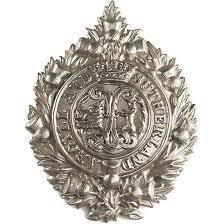276360 Pvt Edward Easton
7th Bn Argyll and Sutherland Highlanders
b. 21 June 1897
d. 3 Sep 1917
Edward Easton was the son of Alexander and Elizabeth Easton, (nee Penman). He was the fifth of their eight children.
BOYS FROM THE GARIBALDI
Edward Easton a coal miner and an employee of Carron Company who enlisted in Alloa for army service on 30 May 1915. The records suggest that that Edward had tried to enlist before he was not quite old enough to join up, but he was posted to 3/7th Argylls, the training battalion based in Alloa. The 3/7th Argylls was a soldier in a holding battalion that would be given basic training and to be progressively prepared for batlle as replacements for the fighting across the channel.
Edward’s enlistment came shortly after the 7th Argylls had gone into action at St Julien, part of the Battle of Ypres (22 April-25 May 1915) which included the battle of St Julien (Sint Juliaan) and which saw the German’s first use of gas in the attack on the colonial French and Canadian battalions holding the front line at Ypres in Belgium. The sector was supposedly a quiet sector of the front and the surprise attack using gas threw the allies into chaos in the unexpected onslaught.
As a result, 7th Argylls, a second line “Territorial Force” battalion were prematurely drawn into the fighting and suffered significant casualties during the St Julien battle of 24th and 25th of April.
The 7th Argylls battalion war diary records that 6 officers and 100 other ranks were killed during the battle, but also that 150 men were posted missing. The total number of casualties in the battalion was over 500, around half of the battalion. The casualties taken by the 7th Argylls meant that replacements would be necessary, and those replacements would come from soldiers in training with 3/7th and others as replacements. The training of recruits in the depot would reflect the realities of the war over the Channel. The records show that Edward embarked at Southampton on 27th September 1915 and joined up with 7th Argylls “in the field” as one of the many replacements necessary to fill the ranks of the fallen.
The men who worked in the mines, and who sometimes died in the mines (like Edward Easton’s brother, George) were the same men who were drawn, willingly or otherwise, into the fighting taking place 400 miles to the south.
THE WILLIAM PIT or “GARIBALDI”
Bothkennar Parish today is something of anachronism. Historically, the parish was a mixture of agriculture and mining, with the iconic Carron Works lay just to the west along the road from Carronshore. The pit village of Skinflats was still an important centre of population but the pits round Skinflats themselves were winding down with the population centre moving to the east and north.
In the 1900’s the pits were in various phases of production, with the older pits stretching northwards from the Carron. Grangemouth to the south was increasingly a vibrant centre of commerce and ship building with the Forth and Clyde canal still playing a part in the moving of goods between the docks at Grangemouth and Glasgow and points between.
Longdyke was created to accommodate mine workers and was once a distinctive pit village. Bothy Row (below) would have been a row of cottages similar to Longdyke. Now, Longdyke no longer exists as just a row of kerbstones to mark what was a thriving pit village.
The miners of Carronshore continued to work the local pits owned by the Carron Company with men from Carronshore, Skinflats and Longdyke working those mines until after the First World War. Mining was central to the communities in the parish: Skinflats, Carronshore and Longdyke. It was from these communities the men who went to war left. Many did not return.
Bothy Row Carronshore - looking north to William Pit and Longdyke
MAP - LONGDYKE AND THE WILLIAM PIT
Edward’s brother, Andrew, of 10th Battalion Argyll & Sutherland Highlanders, had been reported to have died of wounds on 27 September 1915 but, in November, he was reported to be a prisoner of war in Germany – in a camp in Cologne.









